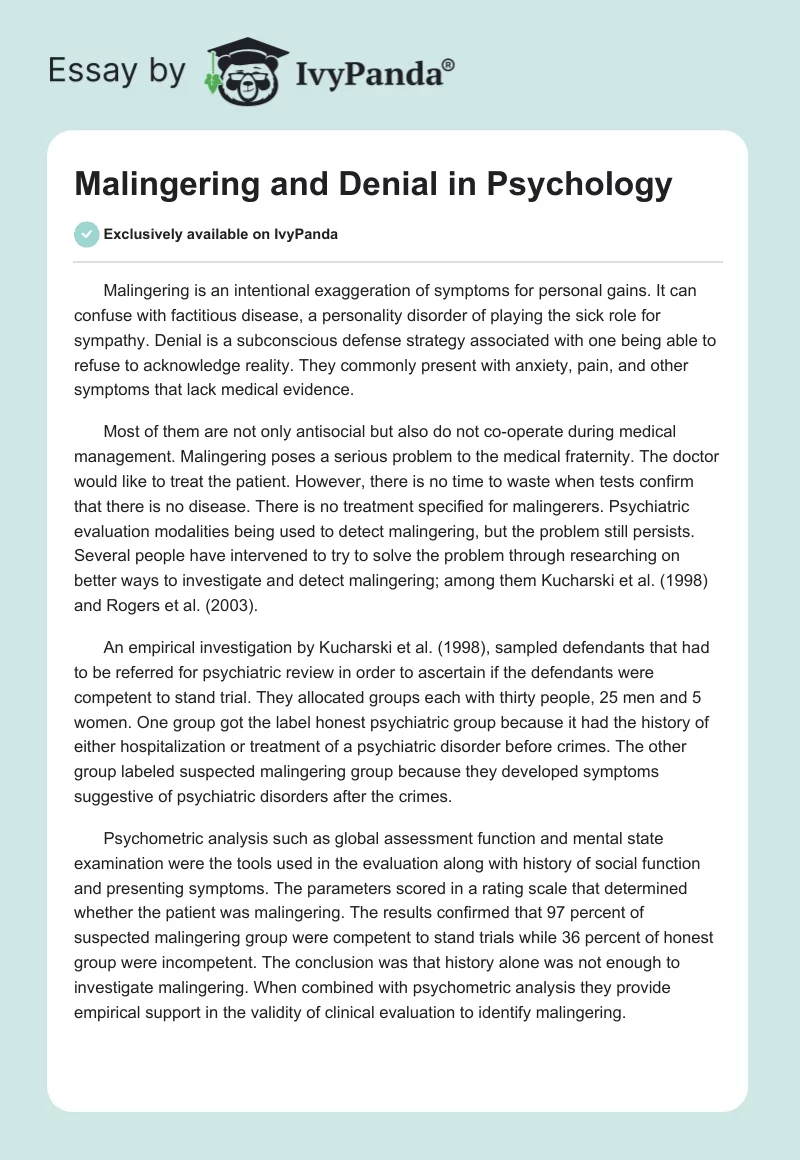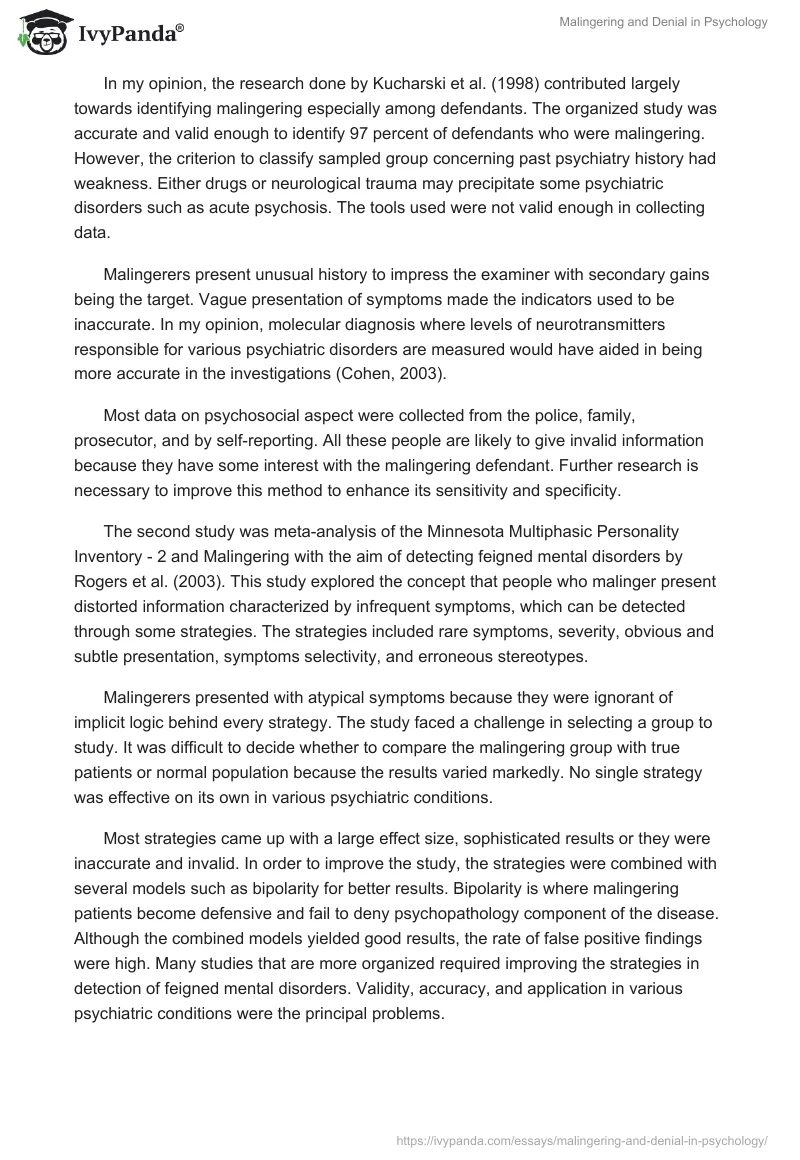Malingering is an intentional exaggeration of symptoms for personal gains. It can confuse with factitious disease, a personality disorder of playing the sick role for sympathy. Denial is a subconscious defense strategy associated with one being able to refuse to acknowledge reality. They commonly present with anxiety, pain, and other symptoms that lack medical evidence.
Most of them are not only antisocial but also do not co-operate during medical management. Malingering poses a serious problem to the medical fraternity. The doctor would like to treat the patient. However, there is no time to waste when tests confirm that there is no disease. There is no treatment specified for malingerers. Psychiatric evaluation modalities being used to detect malingering, but the problem still persists. Several people have intervened to try to solve the problem through researching on better ways to investigate and detect malingering; among them Kucharski et al. (1998) and Rogers et al. (2003).
An empirical investigation by Kucharski et al. (1998), sampled defendants that had to be referred for psychiatric review in order to ascertain if the defendants were competent to stand trial. They allocated groups each with thirty people, 25 men and 5 women. One group got the label honest psychiatric group because it had the history of either hospitalization or treatment of a psychiatric disorder before crimes. The other group labeled suspected malingering group because they developed symptoms suggestive of psychiatric disorders after the crimes.
Psychometric analysis such as global assessment function and mental state examination were the tools used in the evaluation along with history of social function and presenting symptoms. The parameters scored in a rating scale that determined whether the patient was malingering. The results confirmed that 97 percent of suspected malingering group were competent to stand trials while 36 percent of honest group were incompetent. The conclusion was that history alone was not enough to investigate malingering. When combined with psychometric analysis they provide empirical support in the validity of clinical evaluation to identify malingering.
In my opinion, the research done by Kucharski et al. (1998) contributed largely towards identifying malingering especially among defendants. The organized study was accurate and valid enough to identify 97 percent of defendants who were malingering. However, the criterion to classify sampled group concerning past psychiatry history had weakness. Either drugs or neurological trauma may precipitate some psychiatric disorders such as acute psychosis. The tools used were not valid enough in collecting data.
Malingerers present unusual history to impress the examiner with secondary gains being the target. Vague presentation of symptoms made the indicators used to be inaccurate. In my opinion, molecular diagnosis where levels of neurotransmitters responsible for various psychiatric disorders are measured would have aided in being more accurate in the investigations (Cohen, 2003).
Most data on psychosocial aspect were collected from the police, family, prosecutor, and by self-reporting. All these people are likely to give invalid information because they have some interest with the malingering defendant. Further research is necessary to improve this method to enhance its sensitivity and specificity.
The second study was meta-analysis of the Minnesota Multiphasic Personality Inventory – 2 and Malingering with the aim of detecting feigned mental disorders by Rogers et al. (2003). This study explored the concept that people who malinger present distorted information characterized by infrequent symptoms, which can be detected through some strategies. The strategies included rare symptoms, severity, obvious and subtle presentation, symptoms selectivity, and erroneous stereotypes.
Malingerers presented with atypical symptoms because they were ignorant of implicit logic behind every strategy. The study faced a challenge in selecting a group to study. It was difficult to decide whether to compare the malingering group with true patients or normal population because the results varied markedly. No single strategy was effective on its own in various psychiatric conditions.
Most strategies came up with a large effect size, sophisticated results or they were inaccurate and invalid. In order to improve the study, the strategies were combined with several models such as bipolarity for better results. Bipolarity is where malingering patients become defensive and fail to deny psychopathology component of the disease. Although the combined models yielded good results, the rate of false positive findings were high. Many studies that are more organized required improving the strategies in detection of feigned mental disorders. Validity, accuracy, and application in various psychiatric conditions were the principal problems.
Strategies in the study by Rodgers et al. (2003) have the best logic in detecting malingering according to my opinion. The implicit logic in each strategy made it easy to spot out malingerers. The strategy of rare symptoms had a disadvantage in that the word rare was subjective. Symptoms considered rare were applicable in the population without disease. In psychiatric patients, the symptoms considered rare were found in many people. Severity of the symptoms depended on the threshold of a patient’s ability to persevere hence it was subjective too. Although this study looked organized, it shared errors from the secondary sources used in the meta-analysis.
In conclusion, Kucharski et al. (1998) and Rogers et al. (2003) did a good job in trying to solve the problem of malingering. Further studies should aim at improving the areas where these two studies failed. It is through research that we can eradicate malingerers in the health sector. A reliable criterion to identify malingerers and people who are in denial of their conditions is essential.
References
Cohen, J. Bruce. (2003). Theory and Practice of Psychiatry. New York: Oxford University Press.
Kucharski et al. (1998). Clinical Symptoms Presentation in Suspected Malingering: An empirical Investigation. J Am Acad Psychiatry Law, 26(4), 579-585.
Rodgers et al. (2003). Detection of Feigned Mental Disorders: A Meta-Analysis of MMPI-2 and Malingering. Assessment2003, 10(160), 1-7. Web.


